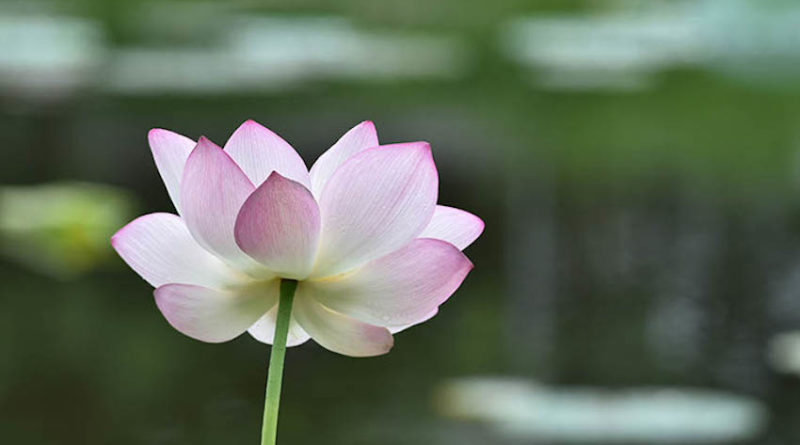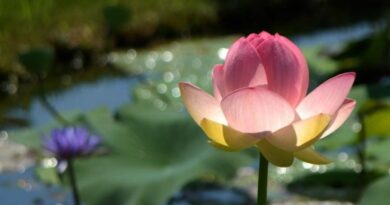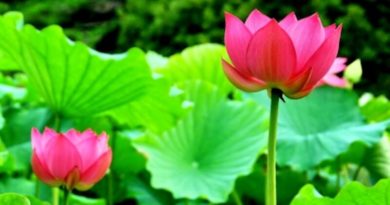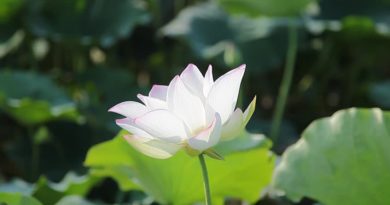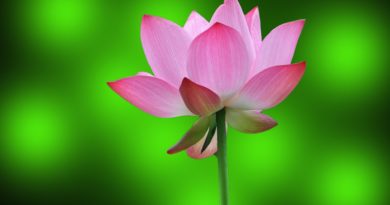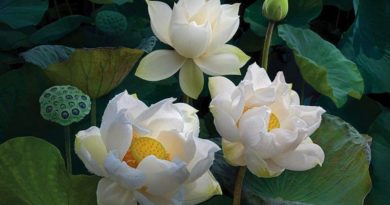HERE AND NOW – CHAPTER 6: KAMMA IS INTENTION
If we want to understand kamma and rebirth correctly, we have to see them in the light of non-self. They proclaim non-self quite vividly and yet most people usually don’t take that into consideration at all, but talk about “my” kamma and “my” rebirth. Especially “my” rebirth, which is absurd. Do they mean the last one or future one? Do we think it will be “me” again? However in ordinary language we have little choice, yet the spoken word has evolved out of our thinking processes.
People often ask what is reborn, if it isn’t “me”? Kamma as a residual effect in the rebirth consciousness is reborn. but it certainly doesn’t look or act like the one we know, doesn’t have the same name, may not have the same form or sex, may not even be human. It has no other connection than kamma. Since we can see quite clearly that the one who is reborn only connects through kamma in the rebirth consciousness with a previous life, we can see just as clearly that kamma is impersonal, without identity. While we talk about “my” kamma, it’s really an impersonal process. It is not crime and punishment, although it may appear like that, and is one of the most commonly held views. Many of our entrenched views are so deeply ingrained that it becomes extremely difficult to understand anything radically different.
Kamma, actually, just means action. In the India of the Buddha, that’s how it was understood. In order to make people aware of what it really implies, the Buddha said: “Kamma, oh monks, I declare, is intention,” which arises first in our thoughts, then generates speech and action. This was the new interpretation that the Buddha gave to kamma, because it was largely misunderstood and used as predetermined destiny. There were teachers in his day that taught it that way, which was denounced by the Buddha as wrong view, misleading and liable to have unwholesome results. This view of pre-determined destiny is just as rampant today as it was at the Buddha’s time. It is often voiced like this: “There’s nothing I can do about it, it’s my kamma.” This is the greatest folly one can adhere to, because it puts the onus of one’s own intentions on some nebulous previous person whom one doesn’t even know. In other words, one doesn’t take responsibility for one’s own actions, which is a very common failing.
It is harder to find a person who does take responsibility than to find one who doesn’t. Most people don’t want to take responsibility for themselves, if they can just manage to stay alive. From that difficulty arises the idea of pre-determined destiny. “What can I do, it’s not my fault, it’s my kamma.” That takes away all possibility for practicing the Dhamma. The Buddha said: “If that were so, the holy life would not be possible, nor would it be feasible to become enlightened.” This is the first wrong view that one has to quickly eliminate from one’s thinking process, if one wants to practice a spiritual discipline.
Kamma is intention, and intention is now, which means kamma is being made now, in every waking moment. However when two people make the same kamma, they do not get the same results. This is another point the Buddha emphasized. Since kamma is impersonal, it is strictly concerned with a flow of events which are creating results by themselves. It’s a matter of cause and effect. That’s all there is, and the Buddha’s teaching is sometimes called the teaching of cause and effect.
Sometimes we see people who are very nice, they would not hurt a fly, and yet a lot of misfortune befalls them. Or others who are difficult and unfriendly, but everything always seems to go right for them. How is it possible? It depends entirely upon their accumulations of good or bad kamma that have resulted in their particular mind continuum. The Buddha gave the following simile: “If one puts a teaspoon of salt in a cup of water, that cup becomes undrinkable. If one puts a teaspoon of salt in the Ganges River, it doesn’t make the slightest difference to the river, the water remains exactly the same.” If one makes bad kamma and has only a cupful of good kamma; the results will be disastrous. If one has a river full of good kamma to support one, the results will be negligible. Therefore, we can never compare the results that people have, because we don’t know their past histories.
The residual mind continuum that we bring with us certainly has a bearing on this life, particularly on where we are born, under what circumstances and in what sort of family. The Buddha gave a simile for that: “If there is a herd of cows locked in a barn, and the barn door is opened, the cow that is the strongest will go out first. If there isn’t one like that, then the one who is the habitual leader will go out first; if there is no habitual leader then the one nearest the door will go out first. If there is none like that, they will all try to go out at the same time” This depicts the mind moments at death. Since death is imminent for everyone no matter what their age, it is skillful to be ready for it now.
The last thought moment at death is the one that impels the rebirth consciousness to its next destination. We can compare that to going to sleep at night and our last thought moment is that we will wake up at four o’clock in the morning. Most people can easily do that. The last thought moment becomes the first one upon waking. Dying is exactly the same, except that the body that wakes up is a new one, and looks different now. It is likely that it will be a human being again, unless one has behaved too badly for such a rebirth. Even though people often wish for rebirth in a deva realm, most people probably return as human beings.
The last thought moment is the one that connects with the strongest experience in this life time. If, for instance, one has murdered a person, that would be a very strong memory and could be the last thought moment. If one has built a monastery or temple that may be a very strong though formation. Or, if one has always kept one’s moral conduct intact, that may be the last thought moment. Whatever is the strongest in one’s mind, that is most likely to arise.
Otherwise one’s habitual thinking takes over. If one has usually been dissatisfied or angry, then that will be in the mind. If one has had much living-kindness, compassion and helpfulness toward others, those thoughts will arise.
If there is no particular thinking habit, then that which comes nearest the sense doors at death takes precedence. The last sense to go is hearing. It is very common, therefore, in most religions that some devotional words are chanted by monks or priests which may help to have a good last thought moment. If these last mental formations are wholesome, one’s rebirth will be favorable. That doesn’t mean that the rest of the kamma resultants disappear. It only means that the impulsion that arises at death takes a certain direction. Therefore the last thought moments are of crucial importance.
If one has been a very generous person, that can be a last thought. It is therefore considered extremely beneficial to remind a dying person of all the good things they have done in this life, such as their generosity, bringing up their children well, their kindness, because ordinary worldlings are apt to have regrets and self-blame. It has in recent years been recognized that dying is a very important part of living, even though in the West many people do not believe in rebirth. Everyone pays a lot of attention to a baby being born, because that baby is going to be around for a long time, and will be an important member of the family. But few have paid sufficient attention to the death moment, because after all that person is gone, finished. but it is now understood that this is not a wholesome way of treating a human being and in the West there are many hospitals for terminally ill and dying people, where great attention is paid to their mind states, to reduce or eliminate fear and anxiety. Yet, hardly anyone there believes in rebirth, but even without that, death is considered very important.
Another factor has entered into our death experience. We are now technologically advanced enough, so that in some instances, people who were clinically dead, could be brought back to life, using new methods that are available in Western hospitals. A number of these people talked to their doctors about their “death” experiences. Some doctors, particularly Dr. Moody, wrote about these phenomena. An outstanding feature of the stories told, is the fact that they were practically identical in their important aspects. This gives us another clue to non-self (//anatta//). All of them, without fail, were extremely pleased with their “death” and reluctant to come back. One woke up extremely angry at the doctor for being instrumental in re-establishing the life continuum.
The experiences were all connected with a very bright light, containing total awareness of the mind, but lacking a body. Each person was able to see his/her own body in the hospital bed and wandered off towards the bright light, quite aware of these occurrences, including watching the doctor at work. Then, removing themselves from the hospital and entering an area of bliss, happiness and great peace, some of them talked about beings they met. Most of them described one particular being which was “light.” None of the descriptions had any religious symbolism in them but all of them were similar, some identical. With such books becoming more widely known the death moment has gained its rightful importance.
In the five daily recollections the Buddha asks us to remember that we are of the nature to die. At other times he talks about the fact that the last thought moment is extremely important and consequently it is essential to get one’s thoughts in order now. On one’s deathbed it’s too late. The wholesome aspects of our thoughts are always connected with loving kindness, compassion, generosity and equanimity. If we arouse those in our minds now, as a habitual way of thinking, we can carry that with us to our deathbed. We are then assured not only of a favorable rebirth, at the very least, but also of harmony during our lifetime. This will make it possible for us to easily practice the Dhamma again. If we are born into a very poor family where nobody has enough to eat, it will be very difficult to sit down in meditation, because in a poor family everybody has to work to survive. If we are reborn in a society where meditation is unknown, it will be very difficult to continue our practice. It is not wise, therefore, to wait till old age and death, but rather get our thinking process in order now. This entails knowing our thought-formation, through mindfulness and attention.
Our appearance here is very short-lived — even 70 years is not very long — so we can think of ourselves as a guest performer, always waiting for applause. Naturally that makes life pretty difficult. First one has stage fright. Is one going to perform properly? Having given the performance, will the applause be following? If one doesn’t get it, one feels devastated. Being a guest performer on this planet is a skillful way of thinking, but waiting for the applause is wrong view. If we know that we’re being the best we can with all our faculties, we don’t have to wait for somebody else’s approval. We can have right intention again and again. That’s what matters most, because intention towards goodness concerns both oneself and others. Less self-concern frees us to embrace others.
We must not decline in Dhamma and meditation practice, of course, because only if we have developed ourselves to some extent, can we help others, otherwise we act in ignorance, which will not bring good results.
If we are concerned with our next rebirth, we are really living in a dream. The person who is making the kamma now is not the one who’s going to reap the results. The only connection will be the kammic residue, the result (//vipaka//). Even this connection is very tenuous, because we can break the chain. If a person has made a lot of bad kamma and in the next rebirth makes much good kamma, the bad resultants may never fruit, and vice versa.
The case in point is Angulimala, who killed 999 people and yet became an Arahant, because he came to be in a monastery under the Buddha where his bad kamma didn’t get a chance to fruit. However, Mahamogallana, already an Arahant, was killed by robbers and his bones pulverized, due to past kamma. We cannot establish a credit account of good kamma against all eventualities, because we have no jurisdiction over the person who will inherit the kamma that we made in this life. But making good kamma now, brings immediate results, happiness and contentment in the mind, and usually some happiness for others also. If one is able to give happiness to others, there is again a cause for joy for oneself.
It’s useless to think about kamma made in a past life, or to be made in a future life. None of us will know anything about the next life, nor do we remember anything from our last life. Why worry about these then? Only this moment, right now, is important. The past is like a dream and the future is yet to come. When the future actually happened, it’s always the present. Tomorrow never comes; when it does, it’s called today. One cannot live in the future nor in the past. One can only live this single moment. If we really paid attention to every single moment, we would meditate well. We would also have no doubt about impermanence (//anicca//). In fact we would see it so clearly, we could let go of our attachments, our clinging.
We could consider thus: “Have I used every moment to the best advantage?” If we have made some bad kamma in the past, we can resolve to quickly perform some good action. That’s the only value the past can provide. Otherwise the most effective and compelling aspect of impermanence is that we are moving away from thought, speech and action so quickly, that we cannot even remember them, never mind hold on to them.
Yet we’re trying to hold on to other people, to our ideas, views and opinions; we hang on to this body, to physical manifestation and mental aberrations and try to make them solid. It’s impossible and cannot be done, there’s only each moment. We can easily see in digital clocks how each moment comes and goes. Just watch a clock for five minutes, and realize five precious moments of your live are gone. The past is actually forgotten, except some highlights, but otherwise it has disappeared. That shows us with clarity that we are a flowing phenomenon without any substance. We’re putting a substance into it, out of an ignorant appraisal of totally untrue reality, in which we are living. It is like a theater, something we have made up ourselves, where people wear costumes and say their lines and believe this to be real life. We want to keep the theater going, but that is not possible and so everybody has //dukkha//, which cannot be eliminated through non-knowing or indifference, but only through a change of awareness and view.
Kamma-making is initially in the mind. Our mental formations make our kamma. Unless we become master of our mind, we cannot escape from making bad kamma. The mind is constantly in danger of thinking something unwholesome. The negativities in the mind are innumerable: “I don’t like it, can’t stand it; I’m afraid, it’s boring…” All are negativities concerned with anger. “I want to get it, keep it, renew it,” are also bad kamma, connected with greed. All arise in the mind.
Very few people watch their mind. They believe it to be difficult and tiring. But it’s much more tiring to make bad kamma, because the results are heavy and unpleasant. Very few people have that inner buoyancy which denotes independent joy. Most people are bogged down by their mind’s negativities, not by outer circumstances. Watching one’s own mind and making sure that one practices the four supreme efforts is the most beneficial thing one can do for oneself, and secures good kamma.
Out of our thoughts arise speech and action. We can’t talk without having thought it first, and we can’t act without having made up our mind to do so. Although people speak and act so impulsively that they are not aware that a thought has gone ahead, that doesn’t mean there was none. It just means that mindfulness and clear comprehension were lacking. Our mind is the most precious asset we have. No jewel can compare with it, because the mind contains the seed of enlightenment. Unless we use it properly, we’re foolishly burying a jewel in the dirt. People often do so, primarily because they have had no training otherwise.
When we recognize that we have this most precious jewel of a mind, we will guard it from being scratched, bumped and dirtied, losing its luster and brilliance, but rather make sure that it remains pure and luminous and thereby make good kamma. The action itself, the Buddha said, is not of the foremost importance, it’s the intention behind it. Even generosity can be extended from a wrong motivation. If the intention is to store up some merit for the future, that’s rather selfish. If it’s done out of compassion for those who have less, that is the ideal way. Yet, even with wrong motivation, it’s still better to be generous than not. There’s good kamma in it, because one has let go of something that one owns.
The guard we keep on our mind will assure that whatever we do is done with right intention, the second step on the Noble Eightfold Path, which is our guideline. Kamma making depends on the mind, and the mind’s purity depends on meditation. If we meditate diligently and regularly, eventually we will see with clarity what goes on in our mind. Some people are satisfied with gaining a little peace, but even that is already an advantage and growth aspect. If we watch the mind in meditation, we will learn to watch the mind also in daily living. Then we have a very good chance of making good kamma.
If we become tired of the ever-recurring cycle of loss and gain, praise and blame, fame and ill-fame, happiness and unhappiness (the eight worldly dhammas), we need to make a determined effort to shed clinging and craving. This effort has meditation as its base, but that’s not all. Meditation is a means for gaining access to the ability to rid oneself of the tendencies of greed and hate. The meditative process gives the mind the clarity to see these tenancies within oneself, so that one can do something about them.
Our duty in this life as human beings with senses and bodies intact, and able to hear the true Dhamma, is to guard our mind and experience its original nature, which is purity, luminosity, pliability. Such a mind can reach the depth of the teaching, where we find nobody that owns the mind.
Source: Budsas.net

